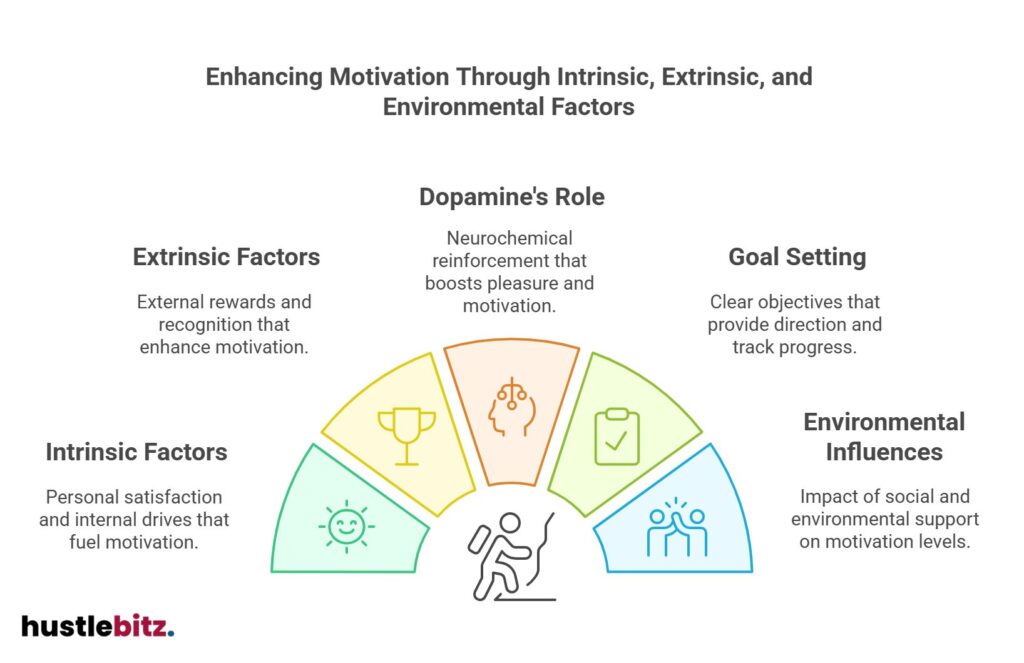Understanding the science of motivation involves exploring the interaction between intrinsic desires, extrinsic influences, and biological factors. Intrinsic motivation arises from personal satisfaction, while extrinsic motivation is driven by external rewards. The neurotransmitter dopamine plays a crucial role, signaling pleasure and reinforcing behavior linked to goals. Effective goal setting directs motivation by providing clear objectives. Additionally, social and environmental contexts significantly shape motivational strategies, enhancing or diminishing drive based on support and recognition. Recognizing the complexity of these components is essential for optimizing motivation in various settings, offering deeper insights into what truly drives us forward.
Key Takeaways
- Motivation is driven by intrinsic factors, like personal satisfaction, and extrinsic factors, such as rewards and recognition.
- Dopamine plays a crucial role in reinforcing goal-related behaviors and enhancing motivation through pleasure signals.
- Goal setting provides clear objectives and direction, which boosts motivation and enables progress tracking.
- Environmental and social influences, including supportive leadership and social networks, significantly impact motivation levels.
- Balancing intrinsic and extrinsic motivation is essential for emotional well-being and sustained engagement in activities.

The Psychology Behind Motivation: Key Theories and Concepts
The psychology of motivation is grounded in several key theories and concepts that elucidate the complex factors influencing human behavior and goal-directed actions. Understanding the science of motivation begins with recognizing that motivation is the driving force behind our behaviors, whether in personal development or academic pursuits.
Two primary types of motivation exist: intrinsic and extrinsic. Intrinsic motivation refers to engaging in activities for their inherent satisfaction, while extrinsic motivation involves external rewards, such as grades or recognition.
Self-determination theory is pivotal in understanding these types of motivation. It posits that individuals are most motivated when they feel autonomous, competent, and connected to others. This theory emphasizes that maintaining motivation is not solely about external rewards; rather, fostering a sense of ownership over one’s goals significantly enhances motivation to learn and achieve.
Goal setting further plays a crucial role in the psychology of motivation. Clearly defined goals provide direction and a sense of purpose, making it easier to channel efforts effectively. By setting specific, measurable, achievable, relevant, and time-bound (SMART) goals, individuals can create a structured path toward success.
Ultimately, understanding these foundational concepts allows us to appreciate the diverse factors that influence motivation. By applying these theories in practical contexts, individuals can enhance their motivation to learn and achieve personal and professional objectives, navigating the intricate landscape of human behavior with greater efficacy.
Intrinsic vs. Extrinsic Motivation: How They Influence Behavior

Intrinsic and extrinsic motivation represent two distinct forces that significantly shape human behavior and influence the pursuit of goals.
Intrinsic motivation arises from within an individual, driven by personal satisfaction, fulfillment, or a genuine interest in the activity itself. This internal source of motivation often leads to enhanced creativity and persistence, as individuals engage in tasks for the joy they bring rather than for external rewards. For example, a person who plays an instrument for their own enjoyment exemplifies intrinsic motivation.
On the other hand, extrinsic motivation involves external factors that encourage behavior, such as rewards, recognition, or the avoidance of negative consequences. This form of motivation plays a crucial role in shaping human behavior, particularly in contexts where tangible outcomes are paramount. For instance, students may study diligently to achieve good grades or earn scholarships, motivated by the external validation associated with academic success.
Understanding the differences in motivation can help inform strategies for effective goal achievement. While both types of motivation are valid and can coexist, intrinsic motivation often leads to deeper engagement and sustained commitment, especially when the motivation for change is self-directed.
In contrast, extrinsic motivation may foster initial action but can sometimes result in dependency on external validation. Recognizing how these internal and external sources of motivation influence behavior is essential for individuals seeking to optimize their approach to achieving goals and fostering lasting change.
The Role of Dopamine in Motivation and Reward Systems
Dopamine plays a pivotal role in the brain’s motivation and reward systems, acting as a neurotransmitter that signals pleasure and reinforces behaviors associated with achieving goals.
This chemical is often referred to as the ’feel-good’ neurotransmitter, as it is integral to both intrinsic and extrinsic motivation. Intrinsic motivation arises from personal satisfaction and fulfillment, while extrinsic motivation is driven by external rewards. Together, they create a dynamic interplay that fuels motivated behavior.
Dopamine acts as a driving force behind the pursuit of rewards, enhancing motivation by fulfilling psychological needs such as achievement and recognition. When individuals successfully reach a goal, dopamine release provides a sense of purpose and satisfaction, encouraging the repetition of behaviors that led to that success.
This process is essential for understanding motivation, as it highlights how our brains are wired to seek positive experiences and avoid negative ones.
Moreover, the role of dopamine extends beyond mere pleasure; it is crucial for learning and adapting behaviors based on past experiences. This learning process enables individuals to navigate their environments effectively, thereby increasing their ability to achieve future goals.
By understanding the mechanisms of dopamine within reward systems, we can better appreciate how motivated behavior is cultivated, allowing for targeted strategies to enhance motivation in various contexts, whether personal or professional.
Understanding the Impact of Goal Setting on Motivation

Goal setting serves as a fundamental mechanism that enhances motivation by providing clear objectives and a sense of direction for individuals striving to achieve their aspirations. Understanding the science of motivation reveals that establishing specific, measurable goals can significantly impact our motivation, acting as a roadmap that guides our efforts. By setting clear goals, individuals are more likely to remain focused and committed, which is essential for sustaining motivation over time.
Goals and aspirations can be categorized into two primary types: intrinsic and extrinsic. Intrinsically motivated individuals pursue goals that align with their personal values and interests, fostering a deeper connection to their objectives. Conversely, extrinsic motivators, such as rewards or recognition, can also drive individuals, yet may not sustain motivation in the long run.
Psychological research indicates that meeting our three innate psychological needs—competence, autonomy, and relatedness—enhances our ability to set and achieve goals. These needs create a force that propels us toward our objectives, ensuring that we remain engaged in the process.
Moreover, setting clear goals allows individuals to track their progress, which can further reinforce motivation by highlighting achievements and milestones.
How Environment and Social Factors Shape Our Motivation

Various environmental and social factors play a crucial role in shaping our motivation, influencing how we engage with tasks and pursue our objectives. Understanding of motivation is deeply intertwined with the context in which we find ourselves.
For instance, workplace environments rich in supportive leadership and teamwork can substantially enhance employee motivation, as positive social interactions often serve as external motivators. The psychology of motivation suggests that both intrinsic and extrinsic forms of motivation are affected by our surroundings.
Elements such as recognition, feedback, and social norms can propel us forward, fostering a climate that encourages goal achievement. Conversely, a toxic or unsupportive environment may stifle motivation, leading to disengagement and decreased performance.
It is essential to recognize the importance of social factors in motivation. Relationships and social networks can provide encouragement and accountability, which are vital in maintaining motivation levels. These factors can create a sense of belonging and purpose, reinforcing our drive to accomplish tasks.
Moreover, the interplay between environmental influences and individual motivation can vary significantly across different contexts. For example, competitive settings may motivate some individuals through the desire to outperform others, while others may thrive in collaborative environments that foster shared success.
Ultimately, understanding how environment and social factors shape our motivation enables us to create more effective strategies for enhancing performance and satisfaction across various domains, particularly in professional settings.
The Connection Between Motivation and Emotional Well-Being

Motivation significantly influences emotional well-being, as it drives individuals to pursue meaningful activities that enhance their overall life satisfaction and psychological health. Understanding this connection involves recognizing the roles of intrinsic and extrinsic motivation.
Intrinsic motivation arises from within, prompting individuals to engage in activities that fulfill their personal values and interests. This form of motivation is closely linked to self-determination, allowing individuals to feel competent and connected to their pursuits, thereby fostering emotional well-being.
Conversely, extrinsic motivation involves external rewards and pressures, which can sometimes lead to temporary boosts in motivation but may not sustain long-term emotional health. When individuals rely solely on extrinsic factors, they may experience feelings of inadequacy if those rewards are not attained, negatively impacting their emotional state.
The interplay between motivation and emotional well-being is further complicated by the basic text terms of relatedness and competence. A sense of relatedness—feeling connected to others—enhances motivation and, in turn, promotes emotional well-being.
Additionally, physiological factors play a crucial role in this dynamic. Motivation influences the decision-making process, affecting how individuals choose to engage in activities that promote their emotional health. When people are motivated to pursue goals that align with their values and interests, they tend to experience greater emotional resilience, satisfaction, and overall well-being.
Thus, fostering a balance of intrinsic and extrinsic motivation is essential for enhancing emotional well-being and achieving a fulfilling life.
How Personal Values and Beliefs Influence Motivation

The interplay between emotional well-being and motivation is often shaped by an individual’s personal values and beliefs, which serve as guiding principles that inform their goals and actions. These intrinsic motivators are crucial in understanding motivation because they not only initiate action but also sustain it, particularly when external motivators may falter. Personal values create a framework for individuals to prioritize their goals, influenced by their unique experiences and aspirations.
Understanding how personal values and beliefs influence motivation can be encapsulated in the following key points:
- Intrinsic vs. Extrinsic Motivation: Intrinsic motivation arises from personal satisfaction and fulfillment, while extrinsic motivators may include rewards or recognition from others. A strong alignment with personal values can enhance intrinsic motivation.
- Hierarchy of Needs: According to Maslow’s hierarchy of needs, personal values can affect the level at which individuals operate, shaping their drive to achieve goals based on their current needs and aspirations.
- Sense of Identity: Personal beliefs contribute to one’s sense of identity, which can either bolster or hinder motivation. When individuals see their goals as aligned with their core beliefs, their motivation strengthens.
- Resilience in Challenges: A robust foundation of personal values fosters resilience, enabling individuals to persevere through obstacles in their pursuit of achieving goals.
Final Thoughts
Understanding the science of motivation reveals that it is a complex interplay of intrinsic and extrinsic factors, influenced by biological, psychological, and social elements. By recognizing the role of neurotransmitters like dopamine, the impact of goal setting, and the importance of environmental and social contexts, we gain deeper insights into what drives us. Balancing these factors can enhance our motivation and emotional well-being, leading to more fulfilling and sustained engagement in our pursuits. Whether in personal or professional settings, aligning our motivations with our values and beliefs is key to achieving lasting satisfaction and success.




